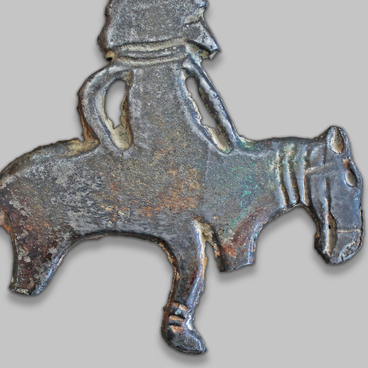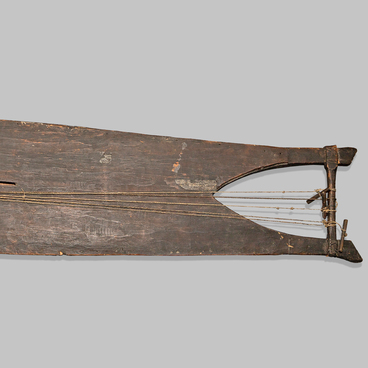The collection of the Tobolsk Provincial Museum has a flat casting in the form of a bird with a human head. It is an element of an archaeological monument, the Istyatskiy Trove, containing cult objects of the Iron Age. It was found when clearing the ditch on post road near Istyatskiye Yurty in Tobolsk province.
The casting is made of bronze. The master cut the head straight. The contour of the face merges with the neck. On one shoulder of the bird, he cast a relief image of a bear, and an unknown animal on the other. On the chest, the master made a relief drawing, as well as stripes that imitate the wings and tail of a bird.
Researchers assumed that the Istyatskiy Trove, part of which is presented in the museum, was found on the remains of an ancient sacrificial site or sanctuary of one of the local Ugric tribes that lived in this territory. The items found were religious and most likely belonged to a shaman serving as the objects of sacrifice or intermediaries assisting in shamanic rites. The connection of birds with the spiritual world is characteristic of Finno-Ugric mythology.
Identification of the soul with the winged image of a bird can be traced in almost all aboriginal ethnic groups of Siberia and the Urals. Narym Selkups believed that there are four souls, and the main one, which represents the life principle, looks like a bird with a human face. The Khanty and Mansi assumed that a living person had five or four souls, while three souls had the appearance of birds. In other words, bird-shaped idols was the receptacle of souls of the dead people.
Bird-shaped idols made of copper and bronze were widely distributed in the Urals and in the West Siberian region. The image of a bird with a human face belongs to the Kulay culture of the early Iron Age. This is the most popular image of that time. The birthplace of the Kulay culture was the taiga territory stretching from the Ural Mountains to the East through the whole of Siberia. This is one of the most striking cultural and historical communities that existed from the middle of the first Millennium BC to the middle of the first Millennium AD. It was named after a treasure found on mount Kulayk in the Chayinskiy District of the Tomsk Region in 1922. It was a bronze cauldron, and small bronze and silver items.
Metal in the regions of Western Siberia and far to the North penetrated from the Urals, from places where the Itkul culture dating back to the first half of the early Iron Age (7th - 3rd centuries BC) was developed. Its territory occupied the areas of mountain-forest and forest-steppe Trans-Urals. Archaeologists point to its Ugric origin. The Itkul culture was named after the Lake Itkul where it was discovered.
The casting is made of bronze. The master cut the head straight. The contour of the face merges with the neck. On one shoulder of the bird, he cast a relief image of a bear, and an unknown animal on the other. On the chest, the master made a relief drawing, as well as stripes that imitate the wings and tail of a bird.
Researchers assumed that the Istyatskiy Trove, part of which is presented in the museum, was found on the remains of an ancient sacrificial site or sanctuary of one of the local Ugric tribes that lived in this territory. The items found were religious and most likely belonged to a shaman serving as the objects of sacrifice or intermediaries assisting in shamanic rites. The connection of birds with the spiritual world is characteristic of Finno-Ugric mythology.
Identification of the soul with the winged image of a bird can be traced in almost all aboriginal ethnic groups of Siberia and the Urals. Narym Selkups believed that there are four souls, and the main one, which represents the life principle, looks like a bird with a human face. The Khanty and Mansi assumed that a living person had five or four souls, while three souls had the appearance of birds. In other words, bird-shaped idols was the receptacle of souls of the dead people.
Bird-shaped idols made of copper and bronze were widely distributed in the Urals and in the West Siberian region. The image of a bird with a human face belongs to the Kulay culture of the early Iron Age. This is the most popular image of that time. The birthplace of the Kulay culture was the taiga territory stretching from the Ural Mountains to the East through the whole of Siberia. This is one of the most striking cultural and historical communities that existed from the middle of the first Millennium BC to the middle of the first Millennium AD. It was named after a treasure found on mount Kulayk in the Chayinskiy District of the Tomsk Region in 1922. It was a bronze cauldron, and small bronze and silver items.
Metal in the regions of Western Siberia and far to the North penetrated from the Urals, from places where the Itkul culture dating back to the first half of the early Iron Age (7th - 3rd centuries BC) was developed. Its territory occupied the areas of mountain-forest and forest-steppe Trans-Urals. Archaeologists point to its Ugric origin. The Itkul culture was named after the Lake Itkul where it was discovered.

